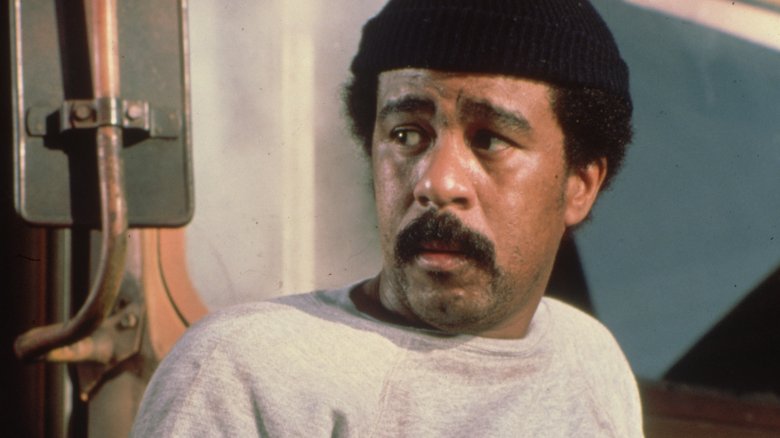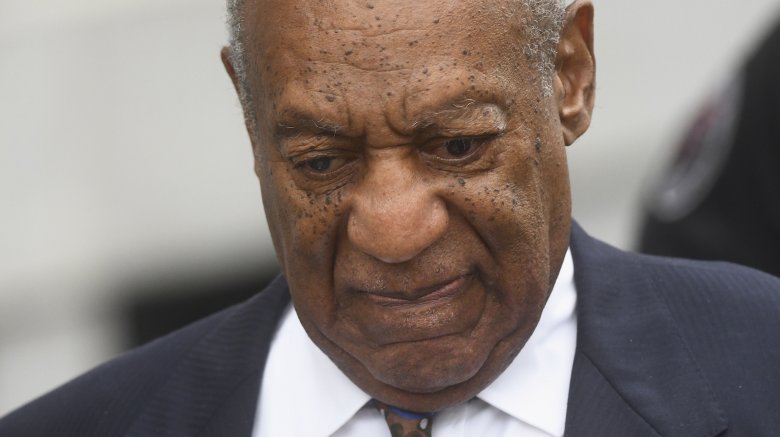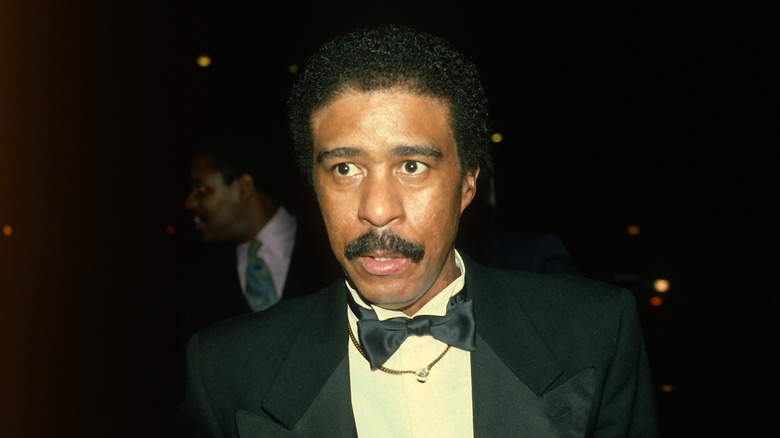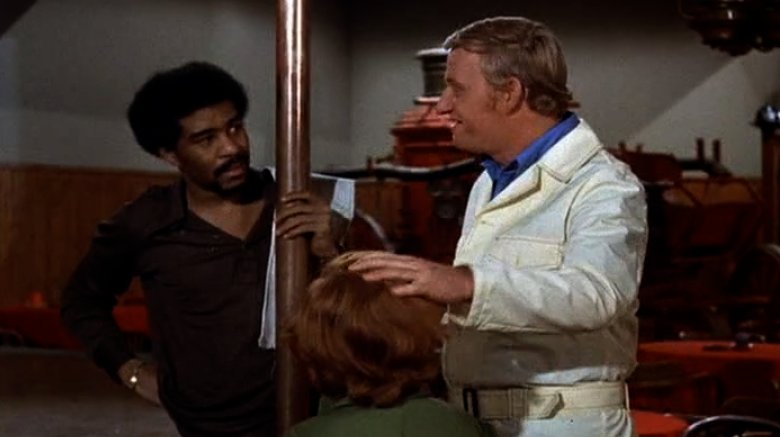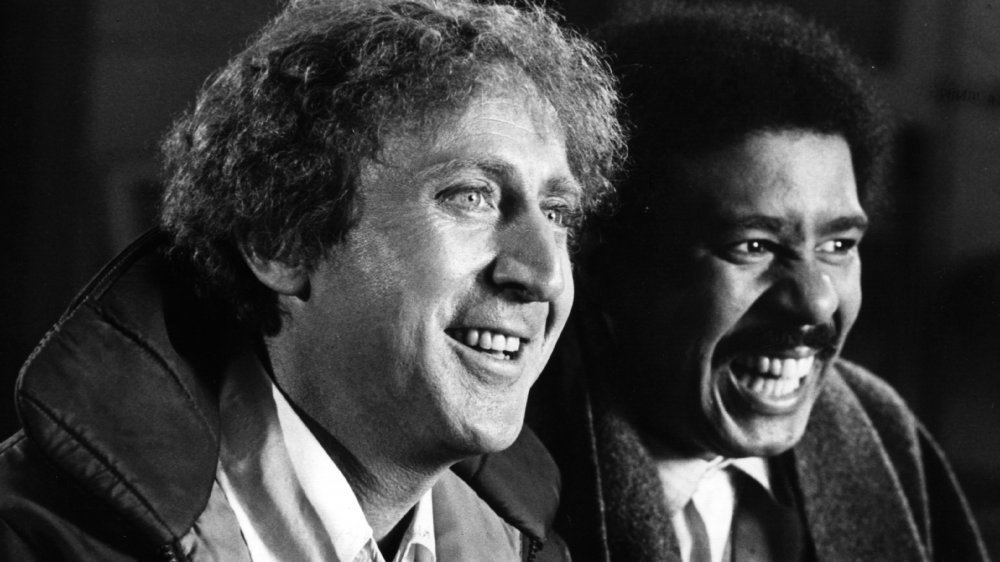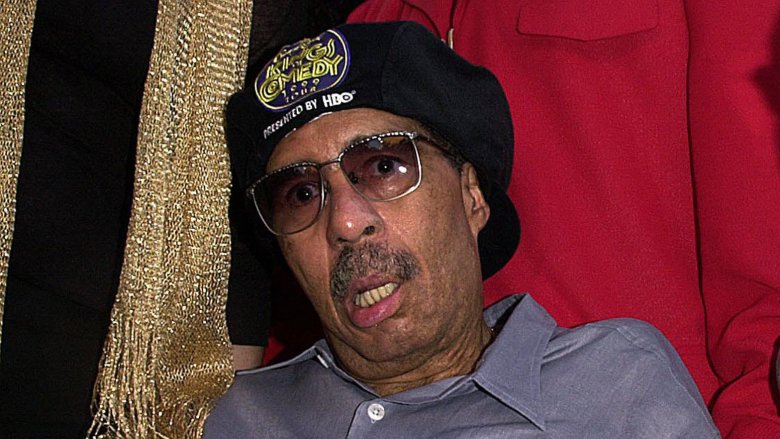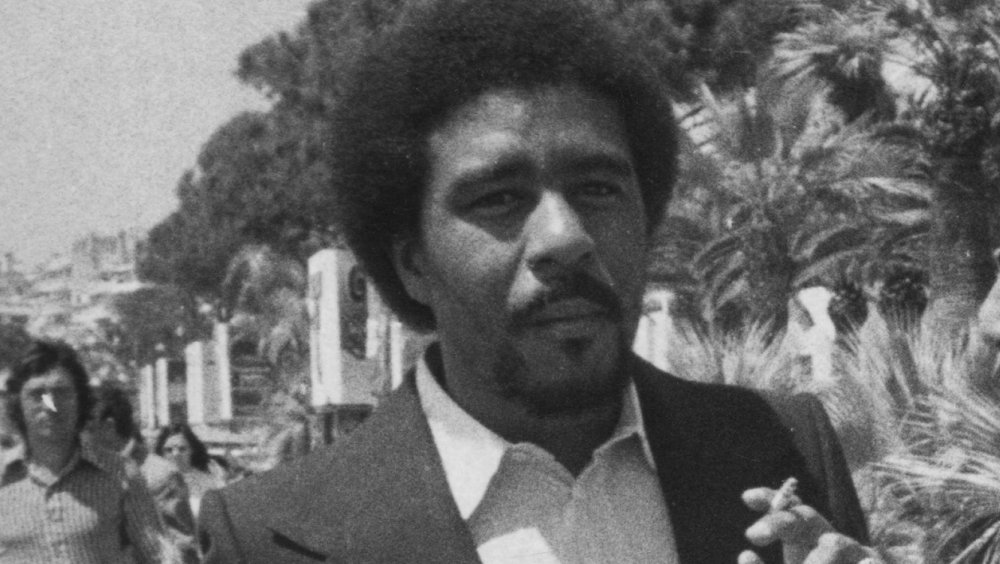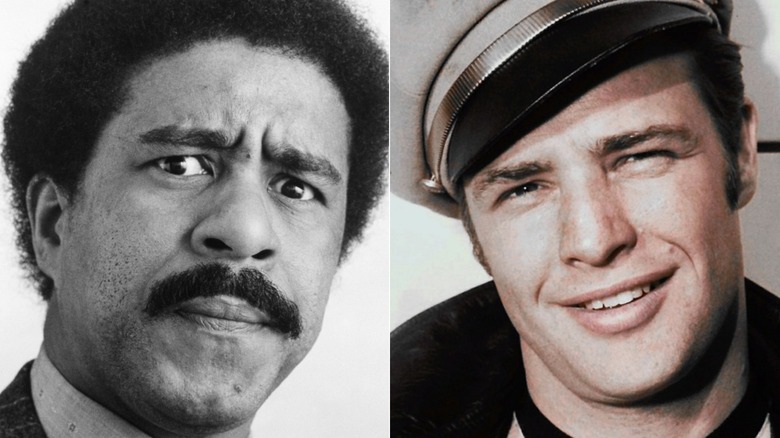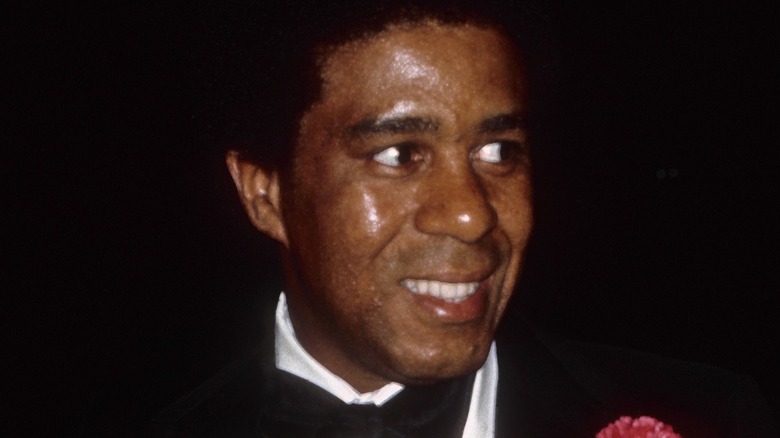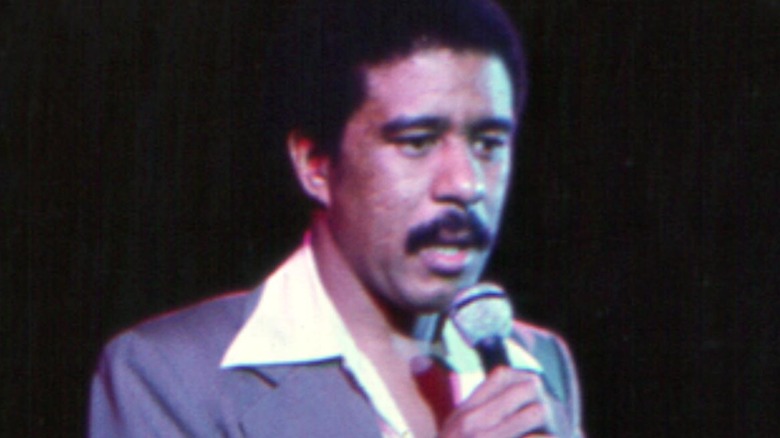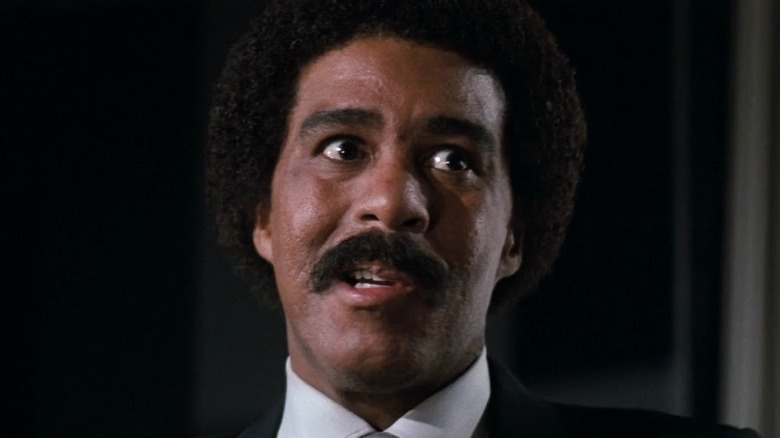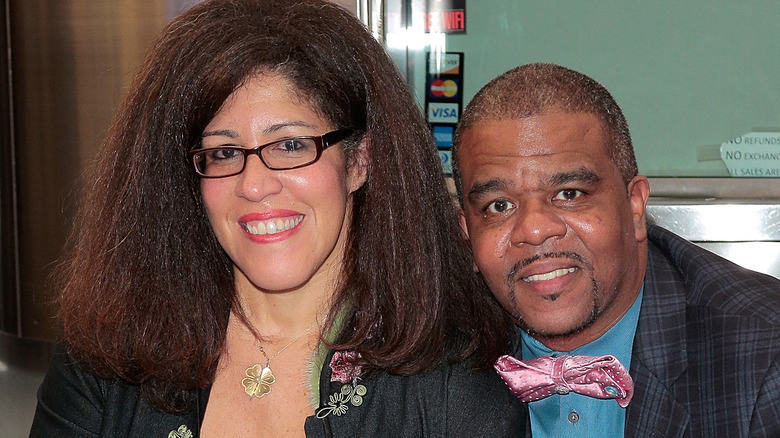The Untold Truth Of Richard Pryor
In 2017, Rolling Stone named Richard Pryor, the man Jerry Seinfeld once called "the Picasso of our profession," the top stand-up comedian in history. Without Pryor's irreverent influence, the comedy world would be a very different place. Yet despite his fame, there are still things you may not know about the comic legend.
His childhood in a whorehouse was even worse than previously thought
"Will it play in Peoria?" is a cliché about the Illinois town representing America's heartland. But the reality of the city when Pryor was coming of age was that it was much more crime-ridden than the old adage suggests. Scott Saul, author of the book Becoming Richard Pryor, wrote that "Far from a blandly typical Midwestern town, Peoria was perhaps America's most unchecked sin city." This was the place where Richard Franklin Lennox Thomas Pryor III, born December 1, 1940, came from.
And as anybody who's heard his stand-up routines about his childhood knows, the home Pryor grew up in wasn't exactly Norman Rockwell material. The comedian was raised in a whorehouse, with his mother a prostitute, his father a pimp, and his grandmother the madam who owned a total of three brothels. The family also owned a tavern and a pool hall and did bootlegging, too. So much for the good old days being more wholesome.
"I saw my mother turn tricks for some drunk white man when I was a kid," he once said. "I saw my father take the money, and I saw what it did to them." One of the women his mother slept with for money was Peoria's mayor.
He saw his father severely beat his mother when he was young before she finally left when he was five. His mother was rough with him as well. Yet Pryor said that it could have been worse. "At least Gertrude [his mother] didn't flush me down the toilet," he said. This wasn't just a comic riff. Pryor once found a dead baby in a box in the house.
Screaming, sexual abuse, and slapstick fill up the rest of Pryor's childhood
If growing up in a whorehouse wasn't enough dysfunction in Pryor's life, he also was molested multiple times, first by a teenage boy he referred to as Bubba when he was six. "For a long time," Pryor told People magazine. "I tried not to think of it." In the 1980s, Bubba approached him at an autograph session when the comedian returned to Peoria. "I went out and signed an autograph for Bubba's son," Pryor explained to People. "But when Bubba left, I said to myself, 'I pray to God his son don't have to go through what I did.'"
His official bio also alleged that a Catholic priest molested him. As The New York Daily News put it, "his dad and uncle plotted to blackmail the priest by encouraging young Richard to flirt with the reverend on the phone," but "Pryor's grandma put an end to that charade." Not exactly a Leave It to Beaver home life.
Pryor did discover something else in his childhood — the ability to make others laugh. When he was in the sixth grade, he was late to school a lot, until his teacher made a deal with him: if he showed up on time, he'd get 10 minutes once a week to perform slapstick routines in front of his classmates. It was his first audience, and it made him want to show up to school on time.
Decades later, Peoria would remember that talent by erecting a statue to honor him.
Richard Pryor initially wanted to be Bill Cosby
In his early standup routines in the early 1960s, Richard Pryor wasn't the profane, irreverent comedian he is remembered as. Instead, he sounded more like Bill Cosby. That was intentional.
”I made a lot of money being Bill Cosby,” he once said to The New York Times, ”but I was hiding my personality. I just wanted to be in show business so bad I didn't care how. It started bothering me — I was being a robot comic, repeating the same lines, getting the same laughs for the same jokes. The repetition was killing me.”
Mark Whitaker, Cosby's biographer, said, "If you go back to really early Richard Pryor, he's looking preppy and talking about childhood and there are a lot of the same sort of mannerisms and so forth as Bill Cosby." Whitaker said Cosby had his manager tell Pryor a few years later to knock it off and be himself.
Cosby later went to see Pryor perform. "I was in the audience when Richard took on a whole new persona — his own," Cosby said. ”Richard killed the Bill Cosby in his act, made people hate it. Then he worked on them, doing pure Pryor, and it was the most astonishing metamorphosis I have ever seen. He was magnificent.” The comedians became friends and later appeared together in the 1978 Neil Simon film California Suite.
Richard Pryor had an epiphany after seeing Dean Martin
Richard Pryor changed from the observational, Cosby-like comedy he started out with to the edgy style he was remembered for after an infamous show at the Aladdin in Las Vegas in 1967. He spotted Dean Martin in the audience, spawning as existential crisis in him. He reportedly asked himself about the audience, "Who're they looking at, Rich?" and didn't know how to respond. "What the f*** am I doing here?" Pryor muttered. He walked off the stage in a moment described as a nervous breakdown. He called it "my nightclub epiphany."
”There was a world of junkies and winos, pool hustlers and prostitutes, women and family screaming inside my head, trying to be heard," Pryor explained. "The longer I kept them bottled up, the harder they tried to escape. The pressure built till I went nuts.”
Richard Pryor spent a few years finding himself, doing experimental comedy and recording more edgy albums, and talking about his real childhood instead of the sanitized version he'd been peddling. He even went to Berkeley and hung out in the counterculture for a while. He set out on his own path, not anybody else's. "I saw myself as a victim of the system, an outsider for whom justice was out of reach, a dream," he wrote in his memoir. "And then I saw how closely my situation mirrored the Black man's larger struggle for dignity and equality and justice in white society. That was me. I was that character."
Pryor once played the drums with Sly Stone and talked about the N word with Dinah Shore
The 1970s were a glorious time in daytime television, when mainstream talk shows sometimes featured the counterculture. It's where housewives learned what was happening outside their white bread world. That's how somebody like Richard Pryor could go on Dinah Shore's show in 1974 and talk about the title of his then-new comedy album, That N*****'s Crazy. She asked him what would be his reaction if she uttered that word, "I'd punch you," he responded. Of course, you'd never see that type of interaction today, for a variety of reasons.
Mike Douglas had Richard Pryor on his show with Sly Stone in 1974, with Pryor playing the drums with the funk musician. And in 1977, Johnny Carson hosted the comedian and Chevy Chase, with Pryor making it clear he couldn't stand the former Saturday Night Live star. "I don't like Chevy," he said. There was the same edge between the two as in that infamous SNL word association skit, but for real this time.
Richard Pryor paired up with the Partridge Family
One of the most mind-blowing episodes of TV ever is seeing Richard Pryor and Louis Gossett Jr. on the goofy music show The Partridge Family. C'mon, get happy, indeed. The 1971 episode "Soul Club" was even named one of the top 100 TV episodes of all time. In the plot, the band accidentally got booked in a Detroit club, while The Temptations were sent to Phoenix, and the usual hilarity ensues — or at least hilarity by the sitcom standards of the day.
But actress Shirley Jones, the mom of the family, didn't find Pryor's act so funny. She complained in her 2013 memoir about Pryor being "so drugged up that he never asked me a thing about myself." Well, what exactly was he going to ask her about? How she got that groovy '70s hairdo or how to clean velvet pantsuits?
Richard Pryor's drug problem kept him from getting a role in Blazing Saddles
For many years, Richard Pryor seemed to subsist on what was described in The New Yorker as "cocaine and Courvoisier." He wasn't exactly secret about that lifestyle either, with him talking about drugs during his stand-up routines. He also was once interviewed in 1980 on the set of Stir Crazy obviously as high as a kite. And Pryor said in his memoir that Jackie Gleason "asked me to get him some grass." And away we go, indeed. He also got high with Miles Davis, among others. (Maybe the question was who didn't Pryor do drugs with back then.)
But while Pryor was riding high in more ways than one in the 1970s, with great career successes, he lost out on one big role — Black Bart, the sheriff in Mel Brooks's 1974 hit comedy Blazing Saddles. Brooks hired him to help write the film and desperately wanted him to play the part.
But Pryor's drugs doomed that. The New Yorker said, "On his first day in the writers' room" for the movie, "he broke out his stash of coke, snorted, and invited the others to share. ('Never before lunch,' Brooks said gamely.)"
Brooks said the drug use kept him from hiring Brooks to act in the movie. "Warner Bros. said, 'No, he has a drug habit. We've done some research. We can't get insurance on Richard Pryor, blah, blah, blah.'" Brooks threatened to quit the film, but Pryor talked him out of it.
Pryor also had a hand in the ultimate casting of Cleavon Little for the role. "Richard really picked him," Brooks shared. "He said, 'Look at that guy. He is really Black. He would scare the s*** out of the entire West.'" Blazing Saddles is a classic movie, but it's interesting to wonder what Pryor would have been like in that role.
It wasn't freebasing that set Richard Pryor on fire
Despite Richard Pryor's career success in the late 1970s, he wasn't in a good way, especially after his grandmother Marie died in 1978. Scott Saul, author of Becoming Richard Pryor, wrote that this passing "had shattered his sense of himself, and he fell into a profound depression. His world contracted into a black hole dominated by his freebase pipe, his paranoia, and his loneliness."
In 1980, Pryor suffered severe burns and nearly died after setting himself on fire. People wrote at the time, "Los Angeles police say he was burned by an explosion while 'freebasing' cocaine." The publication said "Pryor's lawyer denies the report, claiming the injuries were caused by burning rum." The attorney was technically right in that burning rum caused Pryor's injuries. But as Pryor's biographer Saul notes, "On June 9, 1980, Pryor doused himself with a bottle of 151 proof rum and set himself on fire — not by accident, as he first claimed, but by choice. He had lost the will to live. Ironically, setting himself on fire revived it."
That's how messed up Pryor's life was — the idea of him burning himself freebasing cocaine was more palatable than what really happened. According to the 2013 Showtime special Richard Pryor: Omit the Logic, Pryor had just been watching a scene on TV about the Buddhist monk who set himself on fire to protest the war in Vietnam. He ran out into the street to get help and ended up in the hospital. It didn't help that he was wearing a polyester shirt, as it melted to his skin. His life was never the same again.
Richard Pryor's relationships with women were pretty bad
Richard Pryor married seven times (twice to the two of five women). He also had untold affairs and relationships with women, including one with actress Pam Grier, his love interest in the 1977 film Greased Lightning. She wrote in her memoir that he did so much cocaine then that the drug accumulated in her vagina. Yes, really.
And while Pryor had a lot of good qualities, he also was still fighting the demons of his childhood and was prone to fits of rage. That, combined with the drugs and drinking, wasn't exactly a good match. The New Yorker reported that "Pryor regularly beat up women." He also had a thing for guns, shooting up both a car and a fish tank.
His then-ex-wife Jennifer Lee Pryor was interviewed in 1986 in People magazine after the first divorce about Pryor's semi-autobiographical film Jo Jo Dancer, Your Life Is Calling, describing the movie as a "vacuous film" and calling Pryor out as an abuser, saying that it didn't reflect how his life really was. "You told me you watched your father and the pimps beat up the prostitutes, as if they owned them and had the right to hit them. You told me it was that macho myth that made you think beating up women was the way to be a big, strong man. I know, I have the bruises and the hospital records to prove it." Nothing funny about that. Yet she still ultimately remarried Pryor and remained with him until his death.
Richard Pryor had at least one gay experience
In his memoir, he referred to one relationship as homosexual. He described a transgender friend who resembled Josephine Baker. He wrote, "I discovered that she was a he. For some reason, I didn't care ... But after two weeks of being gay ... I went back to life as a heterosexual."
Pryor also got in hot water with LGBT activists for his performance at the "Star-Spangled Night for Rights" benefit show at the Hollywood Bowl in 1977. "I came here for human rights," he said, according to The Guardian, "and I found out what it was really about was about not getting caught with a d*** in your mouth." He added, "You don't want the police to kick your ass if you're sucking the d***, and that's fair. You've got the right to suck anything you want!"
Then he talked very graphically about a sexual relationship he said he had with a boy named Wilbur Harp in 1952, when he was 12. The audience seemed to like what he was saying, but then Pryor started lecturing them about racism and told them to "kiss my happy, rich Black ass." It didn't end well.
The comedian blamed his lifestyle for the MS
In the mid-1980s, after Richard Pryor had quit drugs, he started mysteriously losing weight and looking frail. Rumors swirled around him that he had AIDS, and even Barbara Walters once asked him about it in a 1986 interview. He denied it. Turns out it wasn't AIDS. It was multiple sclerosis, which developed in him when he was 46. For the next two decades of his life, he would battle the disorder.
He described it in People magazine in 1995 as "hell." The magazine said, "But it is, he believes, a hell of his own creation — payback for living on the edge. 'You remember what Malcolm X said after Kennedy was shot, about the chickens coming home to roost?' he asks. 'Well, ol' Rich's chickens came home to roost inside.'"
Eventually, Pryor would lose the ability to walk and even to speak from MS. He only was able to do a few acting roles over the years, like a 1995 performance on Chicago Hope.
But making people laugh meant everything to him. "It's the only thing in my life that's never hurt me," is what Pryor once said about comedy. "That's given me fulfillment. And let me have my dignity. Never belittled me." He kept on trying to laugh through the pain of multiple sclerosis until his death in 2005.
Richard Pryor had a fling with Marlon Brando
In his memoir "Pryor Convictions" (via People) Richard Pryor recounted an affair with a transgender acquaintance which he classified as a "gay" relationship. He openly discussed the relatively fluid nature of his sexuality, but never mentioned a same-sex romance with another ultra-famous pop culture icon of the '70s: "The Godfather" star Marlon Brando.
In a 2018 interview with Vulture, music industry titan Quincy Jones called Brando a "charming" and that he would have sex with "anything" or anyone, including author James Baldwin, singer Marvin Gaye, and Pryor. Pryor's wife, Jennifer Lee Pryor, confirmed the assertion to TMZ, and also stated that it was no big deal, either for her or her late husband, as Pryor was openly bisexual among close associates and wrote about the subject often in his diaries, which she may publish someday.
Lee Pryor later elaborated on the nature of the relationship. "It certainly wasn't an affair, it was a dalliance with Brando, as he had with other men," she told People. "He preferred women over any other kind of experience, but he wasn't loath to have those experiences."
Richard Pryor won a lot of awards
Stand-up comedians who came up in a time period when their form wasn't considered grand art weren't widely awarded. But Richard Pryor was such a dominant force in comedy that accolade-bestowing bodies couldn't ignore him.
In between his two definitive stand-up comedy periods — innocuous observational humor, and incendiary social satire with personal reflection — Pryor was an in-demand screenwriter, and he won some prizes for his efforts. He was nominated for an Emmy Award for his work on "The Lily Tomlin Show" in 1973 and won the following year for the same sketch/variety program. In 1975, Pryor served in the writers' room that created Mel Brooks' comic western "Blazing Saddles," garnering a screenwriting nomination from the BAFTA Awards and winning the WGA Award for feature screenplay from the Writers Guild of America.
Pryor is one of the most acclaimed comedians in Grammy history. In the category of Best Comedy Recording, he was nominated 10 times in the 11-year-period between 1975 and 1985, winning four times, including for "Live on the Sunset Strip," which was named one of the best ever comedy albums by Idolator and Spin. He also took home numerous life and career achievement awards, including one from the Grammys, the American Comedy Awards, the NAACP Image Awards, and in 1998 received the first-ever Mark Twain Prize for American Humor, handed out by The Kennedy Center.
How did Richard Pryor die?
Richard Pryor publicly endured multiple sclerosis, notable for its debilitating and devastating physical and neurological effects, which he discussed at length in People in 1995, a decade before his death in December 2005 (per NPR). But it wasn't that disease that ultimately claimed the life of the comedian, actor, and writer, nor was it the effects of his long, well-documented substance abuse issues.
According to the performer's business manager, Karen Finch (via the New York Times), Pryor's health rapidly deteriorated while he was at his home in the San Fernando Valley of Southern California. His wife, Jennifer Lee Pryor, told the media that the comic had been cheerful in what amounted to his last days. Richard Pryor suffered a heart attack at his residence, and was thereafter rushed to a hospital in Los Angeles. Shortly after his arrival, doctors pronounced his death, citing the heart attack as the official cause. Richard Pryor was 65.
What was Richard Pryor's net worth?
Richard Pryor wasn't only one of the most influential entertainers in the world for the better part of three decades in the mid-20th century, but he was also one of the most wildly successful. According to The Numbers, his films made more than $800 million at the box office (and that's not accounting for inflation). Among his biggest hits: the 1980 Gene Wilder buddy comedy "Stir Crazy" (with a $101 million take) and the blockbuster 1983 sequel "Superman III." For his role as comic relief/accidental villain Gus Gorman, Pryor earned $4 million, making him one of the highest-paid movie stars in history to that point, according to the New York Times.
And while Pryor filled concert halls and comedy clubs whenever he toured, the recordings of those shows were even more financially agreeable for the performer. According to the Recording Industry Association of America, three of his albums sold at least 500,000 copies each, while "Is It Something I Said?" and a greatest hits album both sold well over a million units.
All those record royalties, and residual payments on movies he starred in or co-wrote meant the money kept coming in for Pryor after he retired from performing and even following his death. According to Celebrity Net Worth, Pryor left behind an estate worth $40 million when he died in 2005.
Richard Pryor had seven children
Richard Pryor's personal life was robust and well-populated. According to Yahoo!, he was married seven times to five different women: Patricia Price in the early '60s, Shelley Bonus in the late '60s, Deborah McGuire briefly in the '70s, Jennifer Lee from 1981 to 1982, Flynn Be-Laine from 1986 to 1987 and again from 1990 to 1991, and then once more to Lee from 2001 to his death. Altogether, he fathered seven children, four with women to whom he was married or would marry, and three with girlfriends and domestic partners. In order, they are: Renée (born when Pryor was 17), Richard Pryor Jr. (pictured right), Elizabeth, Rain Pryor (pictured left, a singer, author, and actor on the '80s sitcom "Head of the Class" and a theatrical performer and playwright), Steven, Franklin, and Kelsey (per ABC News).
According to Forbes, Jennifer Lee Pryor was left fully in charge of her husband's finances and legacy; she was named the primary beneficiary of the comedian's estate as well as the executor of his image and intellectual property. That appointment was a late-breaking addition to Pryor's will and trust, and Elizabeth, Rain, and Richard Pryor Jr. filed suit against Lee Pryor, which included accusations of elder abuse, exploitation, and financial malfeasance. Lee Pryor came out victorious in the legal battles.
